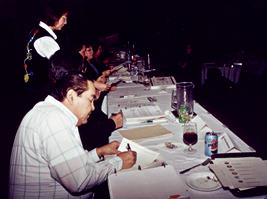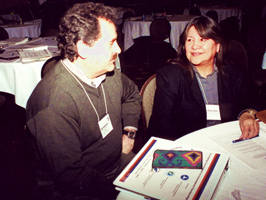 |
Linda Aitken (standing),
Mn/DOTís tribal liaison, observes as representatives from Mn/DOT, the
FHWA and tribal governments sign the historic "Government to Government
Transportation Accord" in Hinckley on April 1. Photo by Craig
Wilkins
|
Pledging mutual support and cooperation in future endeavors, officials from
Mn/DOT, the Federal Highway Administration and seven Minnesota American Indian
tribes signed an historic agreement April 1 to share resources, energy and commitment
for meeting the stateís growing transportation needs.
The parties signed the agreement during the first "Tribes and Transportation
Summit" held in Minnesota. The summit was designed to improve working relationships
and engender mutual respect for the roles and responsibilities of federal, state
and tribal governments.
The agreement, the "Government to Government Transportation Accord,"
calls on its signers to advance their mutual goals, create a practical framework
for partnerships, and respect the governmental integrity and the cultures and
values of each party to the accord.
Gov. Jesse Ventura honored the signing of the agreement by issuing a proclamation
marking April 1, 2002, as "Tribes and Transportation Day" in Minnesota.
The three-day conference at the Grand Casino in Hinckley drew more than 100
participants.
Common transportation heritage
Opening the conference, Bobby Whitefeather, chairman of the Red Lake Band of
Chippewa, reminded participants of their common interests and heritage, citing
the earliest forms of transportation in Minnesota when the first settlers used
canoes and toboggans for hunting, traveling and fishing, and runners to carry
messages to outlying settlements.
"If you fly low over the Big Bog of northwestern Minnesota," he said,
"you can still see the trails the runners made."
During the event, participants stressed the importance of acknowledging differences,
protecting the natural environment, showing respect for each governmentís sovereignty
and legitimacy and listening thoughtfully to create the basis for lasting cooperative
efforts.
The conference enabled representatives from the tribes, Mn/DOT, the FHWA, the
Bureau of Indian Affairs and other agencies to explore ways to coordinate their
involvement with transportation projects on or near tribal lands in Minnesota.
Panels and workshops at the conference explored topics such as preserving cultural
resources, acquiring right of way in Indian-owned lands, focusing on Indian
employment issues and strengthening the economic health of all the stateís communities
by improving highways, bridges, transit and other transportation modes.
 |
|
Curt Eastlund, District
3 pre-design engineer, and Elisse Aune, historic preservation officer
with the Mille Lacs Band of Ojibwe, meet informally during the conference
to discuss cultural preservation issues. Photo by Craig Wilkins
|
Landmark relationship
Melanie Benjamin, chief executive of the Mille Lacs Band of Ojibwe, said the
conference and signing of the agreement mark an important landmark in the relationship
between the tribes and state and federal governments.
"Itís crucial for us to sit down and establish partnerships that benefit
all of our communities because they are all so inter-related," Benjamin
said. "The conference and the agreement will promote understanding, help
us hold each other accountable and make life better for all of our constituents."
Other conference participants echoed Benjaminís thoughts, including Alan Steger,
administrator for the Minnesota Division of the FHWA.
"State and federal highways donít stop at tribal borders," he said.
"The agreement demonstrates a commitment by the FHWA, Mn/DOT and the tribal
governments to foster increased cooperation on transportation projects."
Steve Voss, District 3 planning director, said the conference will expand efforts
already under way in the district. He said, for example, that both reservations
in District 3 hold voting positions in the Area Transportation Partnership and
that the BIA holds a non-voting membership.
"The conference presents an opportunity to bring issues to the table and
improve our working relationships at the planning level."
Vossís colleague, pre-design engineer Curt Eastlund, said the meeting will
help improve relationships with the tribes when the district is involved in
challenging projects such as rebuilding Hwy 169 near Lake Mille Lacs.
ĎDo it rightí
After reading the governorís proclamation, Commissioner Elwyn Tinklenberg said
the words in the agreement are important, but the accordís true value will be
shown by how the signatories achieve its goals.
Echoing Tinklenbergís remarks, Whitefeather spoke at length in Ojibwe and then
said: "That was a quote from my grandfather. It means, ĎDonít do it just
any old wayódo it right.í"
By Craig Wilkins
|



